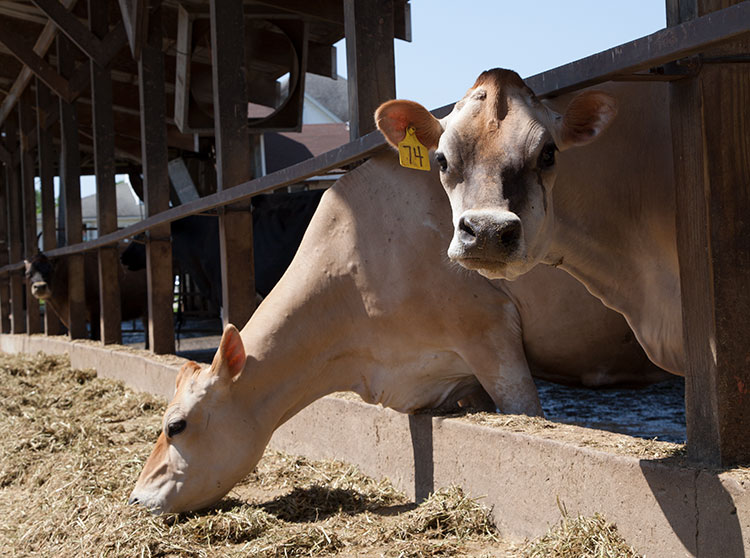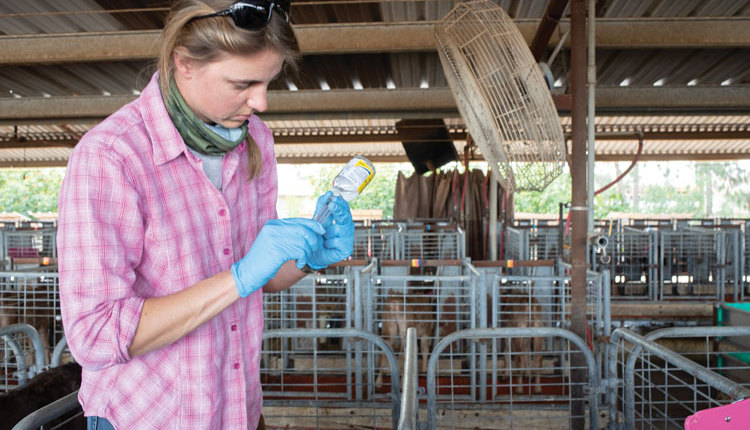The authors are a dairy extension educator for Michigan State University and a professor in Michigan State University’s Large Animal Clinical Sciences Department.


Thirty years ago, a cow peaking at 90 pounds of milk per day was considered to be a “high producer” in many herds. Today, entire herds average 90 pounds per day, or even more. But high milk production brings new challenges, one of them being the beginning of the dry-off period.
The dry period impacts a cow’s health and production in the subsequent lactation. During the dry period, the udder “renews” milk-producing tissue and creates a hostile environment that favors the elimination of mastitis-causing bacteria. So, what is the best way to dry off a cow?
The latest USDA-National Animal Health Monitoring System (NAHMS) study (2016) reported that close to 74% of farms abruptly stop milking cows as a dry-off method. This approach may be a problem, though, for cows that are producing 85 to 90 pounds of milk at dry-off.
What about gradually spreading out the milking interval by going from 3x to 2x or 2x to 1x? How about reducing the feed intake or the content of the ration? What are the consequences of these approaches, as opposed to following the traditional plan, in terms of leaking milk and udder health?
Ideally, cows should have lower milk production at dry-off in order to:
1. Reduce the risk of leaking milk and pathogens entering the udder.
2. Allow the “keratin plug” to seal the teat canal.
3. Reduce udder swelling and any associated discomfort.
4. Enhance a more rapid udder involution (rebuilding).
A recent review concluded that daily production of 33 pounds or less at dry-off is recommended to improve udder health. This is unrealistic for most cows and a challenge for most producers. Yet, failure to reach lower milk production at dry-off can lead to problems.
Consistent conclusions
Numerous studies have compared drying off between higher and lower producing cows, and although there were differences in the trial designs, there were some consistent conclusions. Higher producing cows are less likely to form the keratin plug, more likely to leak milk, and more likely to have new infections over the dry period.
This is problematic because cows with a high somatic cell count (SCC) at the start of lactation are more likely to have clinical mastitis and will lose an average of 1,600 pounds of milk by 305 days compared to cows that are not infected. Thus, producers should have a plan for high-producing cows at dry-off to prevent subclinical mastitis that masquerades as a high somatic cell count.
Animal welfare brings another perspective of drying off high-producing cows. When milking is stopped, the accumulation of milk in the udder causes discomfort and pain, and cows with higher milk production at dry-off may experience this with greater intensity.
The potential options
Below is a brief review of the methods that may help reduce milk production at dry-off:
Nutritional changes: Restricting or reducing energy of the ration has been advocated to reduce milk yield. However, this can lead to metabolic problems, including impacts on the immune system and hypocalcemia, and depending on the strategy, can cause hunger and stress in cows. Ration changes must be carefully assessed by the herd veterinarian and nutritionist and should only be short-term. In addition, it is impractical to apply this strategy to small numbers of “special needs” cows as bunk space and grouping is limited in many dairy herds.
Changes in milking management: Reduced milking frequency might be the easiest way to diminish milk yield, especially in late-lactation cows. For example, paring down milking frequency from twice to once per day for five to seven days before dry-off will often slow down production. When compared to abruptly stopping milking, this method is more effective at reducing milk yield and preventing mastitis.
This strategy requires the identification of the cows that are being “trained to dry off.” One solution may be to use Velcro leg bands of one color, which can be exchanged for another color once the dry cow treatment protocol is applied. This method could avoid the need for a separate milking group.
Newer technologies, such as milking robots and parlor management-added technologies, represent promising new alternatives to manage milking frequency. Robots can be programed to limit the number of milkings per day for specific animals and to remove milking units earlier during milking; for example, they could be removed at a “wetter” setting with higher milk flow.
Cow-specific early removal of milking units, relative to milk yield, also has been achieved in conventional parlors with newly developed software. The software monitors the targeted yields compared to previous yields and triggers the automatic removal of units. A German study reported that cows that were milked by a “targeted reduced milk yield” had lower milk production at dry-off than cows milked using the normal take-off settings for the herd.
Drugs (such as cabergoline) that lower milk production by blocking the production of prolactin, an essential hormone for milk production, have also been studied as a way to attain lower milk production at dry-off. Although these drugs have been successful at slowing milk production, their commercialization has not been approved in the U.S. and was stopped in the EU due to reports of severe secondary effects, including down cows and death.
Talk to others
Drying off cows is a critical part of the cow’s lactation cycle, and dairy producers should reconsider their protocol for higher producing cows. Consult your herd veterinarian and nutritionist to evaluate current dry-off practices, and take into account the production level at dry-off, udder health in early lactation cows, future lactation performance, and animal welfare. This needs to include a review of the use of dry cow treatment, internal teat sealants (and the proper use of infusion techniques), and the dry cow environment.
Herds that have individual cow SCC records are in a position to better know if changes in their dry period program are impacting udder health, particularly by tracking new infection rates of subclinical mastitis over the dry period and the proportion of fresh cows with high SCC or clinical mastitis.
The portal “Monitoring new infections in dry cows” found at on.hoards.com/QMAdrycowinfection offers metrics for tracking subclinical mastitis after calving. It was developed by the Quality Milk Alliance.







